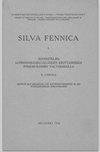Reuse of field data in ALS-assisted forest inventory
IF 1.8
3区 农林科学
Q2 FORESTRY
引用次数: 6
Abstract
Forest inventories assisted by wall-to-wall airborne laser scanning (ALS), have become common practice in many countries. One major cost component in these inventories is the measurement of field sample plots used for constructing models relating biophysical forest attributes to metrics derived from ALS data. In areas where ALS-assisted forest inventories are planned, and in which the previous inventories were performed with the same method, reusing previously acquired field data can potentially reduce costs, either by (1) temporally transferring previously constructed models or (2) projecting field reference data using growth models that can serve as field reference data for model construction with up-to-date ALS data. In this study, we analyzed these two approaches of reusing field data acquired 15 years prior to the current ALS acquisition to estimate six up-to-date forest attributes (dominant tree height, mean tree height, stem number, stand basal area, volume, and aboveground biomass). Both approaches were evaluated within small stands with sizes of approximately 0.37 ha, assessing differences between estimates and ground reference values. The estimates were also compared to results from an up-to-date forest inventory relying on concurrent fieldand ALS data. The results showed that even though the reuse of historical information has some potential and could be beneficial for forest inventories, systematic errors may appear prominent and need to be overcome to use it operationally. Our study showed systematic trends towards the overestimation of lower-range ground references and underestimation of the upper-range ground references.在als协助的森林清查中重新使用实地数据
在许多国家,由机载激光扫描(ALS)辅助的森林清查已成为普遍做法。这些清单的一个主要费用组成部分是测量用于构建将森林生物物理属性与ALS数据得出的指标联系起来的模型的实地样地。在计划利用ALS辅助森林调查的地区,以前的调查是用同样的方法进行的,重复使用以前获得的实地数据可能会降低成本,方法是:(1)暂时转移以前构建的模型,或(2)利用生长模型预测实地参考数据,这些模型可以作为利用最新ALS数据构建模型的实地参考数据。在这项研究中,我们分析了这两种方法,利用目前ALS采集前15年获得的野外数据来估计6个最新的森林属性(优势树高、平均树高、茎数、林分基础面积、体积和地上生物量)。这两种方法都在大约0.37公顷的小型林分中进行了评估,评估了估计值与地面参考值之间的差异。还将这些估计值与最新森林清查结果进行了比较,清查结果依赖于同时进行的实地和ALS数据。结果表明,尽管重新使用历史资料有一些潜力,而且可能有利于森林清查,但系统错误可能显得突出,需要加以克服才能在业务上加以利用。我们的研究显示了低距离地面参考资料高估和高距离地面参考资料低估的系统性趋势。
本文章由计算机程序翻译,如有差异,请以英文原文为准。
求助全文
约1分钟内获得全文
求助全文
来源期刊

Silva Fennica
农林科学-林学
CiteScore
3.50
自引率
11.10%
发文量
21
审稿时长
3 months
期刊介绍:
Silva Fennica publishes significant new knowledge on forest sciences. The scope covers research on forestry and forest ecosystems. Silva Fennica aims to increase understanding on forest ecosystems, and sustainable use and conservation of forest resources. Use of forest resources includes all aspects of forestry containing biomass-based and non-timber products, economic and social factors etc.
 求助内容:
求助内容: 应助结果提醒方式:
应助结果提醒方式:


